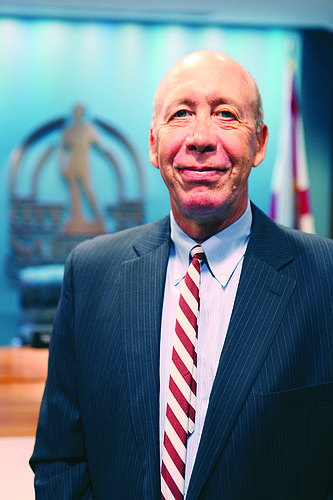- July 8, 2025
-
-
Loading

Loading

After scuttling plans for a come-as-you-are homeless shelter against the recommendations of consultant Robert Marbut last summer, the city has been faced with a tough question: What now?
Homeless issues have been a leading concern for city residents and officials. Although the city has taken some steps toward addressing those issues — including the authorization of the Sarasota Police Department’s homeless outreach teams — many have questioned the city’s responsiveness to homelessness and associated problems.
At the April 6 City Commission meeting, City Manager Tom Barwin took a big-picture swing at figuring out what the city’s next step should be. Barwin presented an eight-point plan to commissioners, built around a housing-first model that has produced positive results nationwide. The city — and others — would focus on increasing the affordable housing stock and getting homeless individuals into housing as quickly as possible.
Barwin said the conversations that produced his recommendations began more than two years ago, and his presentation was forged with input from service providers and homeless individuals gathered over the past nine months. Based on those conversations, he’s confident he can get buy-in from the homeless population and organizations such as the Salvation Army.
He’s also optimistic about the likelihood of engaging private developers, whom he is challenging to form a coalition to construct 100 housing units per year over a five-year period. He’s had conversations with the Greater Sarasota Chamber of Commerce, an organization that’s interested in helping with that effort.
The chamber is a key participant in the recently founded “Q Life” initiative, a group of local organizations focused on addressing homelessness issues to improve the quality of life in the region. In March, the group hosted a visit from Greg Shinn, who helped implement a housing-first program in Tulsa, Okla.
“We’re moving in a positive direction,” said Kevin Cooper, the chamber’s vice president for public policy. “We need to start diffusing that culture and making that our story.”
Even if those groups are on board, one major player looms large: Sarasota County, whose relationship with the city is tense at the moment. The county and city jointly hired Marbut in 2013, but the two commissions haven’t met to discuss homelessness since the city withdrew from the shelter talks in summer 2014.
Barwin said he has kept in touch with county homelessness coordinator Wayne Applebee, who has requested that the city keep the county abreast of its progress. He’s hopeful that, if the City Commission backs his recommendations at a future meeting, the County Commission will be open to rekindling discussions.
“It shouldn’t be a political debate,” Barwin said. “There shouldn’t be winners and losers. This should really be an adult, informed analysis in which we all keep learning as we go until we get to the best success possible.”
Despite Marbut’s professed expertise — including developing a come-as-you-are shelter in Pinellas County — Barwin said the discussions surrounding his recommendations weren’t as productive as he would have liked.
Barwin frequently expressed concerns about Marbut’s recommendation of a shelter located near the jail and other existing service providers, arguing that the city was already disproportionately responsible for bearing the burden of homeless issues countywide. Barwin still maintains a homeless facility should be centrally located in the county.
“I think we certainly respected Dr. Marbut’s experience, but he came here with a cookie-cutter plan,” Barwin said. “There were deadlines, and I think we really didn’t have the honest, healthy exchange of ideas that was necessary to craft a local solution.”
In Barwin’s vision, a much smaller shelter would focus on getting chronically homeless individuals off of the street as soon as possible, avoiding patterns that have kept the chronically homeless on the streets for an average of nearly four years, per a recent city survey.
Barwin’s recommendations are still relatively new — even though several commissioners have offered general support, the City Commission itself will not adopt any of them until its next meeting. Still, he hopes the buy-in will come swiftly, and that the city will soon be able to take long-awaited steps to address homelessness.
“This feels like a more holistic approach, and, over time, an approach that will provide better results for individuals and better results for the community,” Barwin said. “That’s our hope.”
“This feels like a more holistic approach, and, over time, an approach that will provide better results for individuals and better results for the community.”
— City Manager Tom Barwin